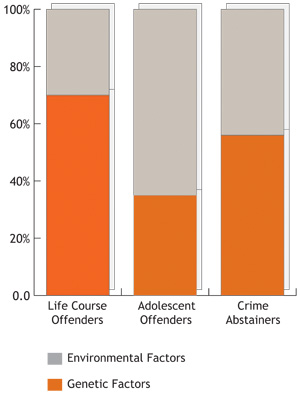Criminologist’s Research Shows Genes Influence Criminal Behavior
By: Office of Media Relations | Jan. 24, 2012

Your genes could be a strong predictor of whether you stray into a life of crime, according to a research paper co-written by UT Dallas criminologist Dr. J.C. Barnes.
“Examining the Genetic Underpinnings to Moffitt’s Developmental Taxonomy: A Behavior Genetic Analysis” detailed the study’s findings in a recent issue of Criminology. The paper was written with Dr. Kevin M. Beaver from Florida State University and Dr. Brian B. Boutwell at Sam Houston State University.
The study focused on whether genes are likely to cause a person to become a life-course persistent offender, which is characterized by antisocial behavior during childhood that can later progress to violent or serious criminal acts later in life.
The framework for the research was based on the developmental taxonomy of anti-social behavior, a theory derived by Dr. Terri Moffitt, who identified three groups, or pathways, found in the population: life-course persistent offenders, adolescent-limited offenders and abstainers. Moffitt suggested that environmental, biological and, perhaps, genetic factors could cause a person to fall into one of the paths.
Genes Show Connection to Crime

“That was the motivation for this paper. No one had actually considered the possibility that genetic factors could be a strong predictor of which path you end up on,” said Barnes, who is an assistant professor of criminology in the School of Economic, Political and Policy Sciences at UT Dallas. “In her (Moffitt’s) theory, she seems to highlight and suggest that genetic factors will play a larger role for the life-course persistent offender pathway as compared to the adolescence-limited pathway.”
Adolescent-limited offenders exhibit behaviors such as alcohol and drug use and minor property crime during adolescence. Abstainers represent a smaller number of people who don’t engage in any deviant behavior.
Barnes and his co-researchers relied on data from 4,000 people drawn from the National Longitudinal Study of Adolescent Health to identify how people fell into each of the three groups. The researchers then compared the information using what is known as the twin methodology, a study design that analyzed to what extent genetic and environmental factors influenced a trait.
“The overarching conclusions were that genetic influences in life-course persistent offending were larger than environmental influences,” he said. “For abstainers, it was roughly an equal split: genetic factors played a large role and so too did the environment. For adolescent-limited offenders, the environment appeared to be most important.”
The analysis doesn’t identify the specific genes that underlie the different pathways, which Barnes said would be an interesting area for further research.
“If we’re showing that genes have an overwhelming influence on who gets put onto the life-course persistent pathway, then that would suggest we need to know which genes are involved and at the same time, how they’re interacting with the environment so we can tailor interventions,” he said.
Barnes said there is no gene for criminal behavior. He said crime is a learned behavior.
“But there are likely to be hundreds, if not thousands, of genes that will incrementally increase your likelihood of being involved in a crime even if it only ratchets that probability by 1 percent,” he said. “It still is a genetic effect. And it’s still important.”
The link between genes and crime is a divisive issue in the criminology discipline, which has primarily focused on environmental and social factors that cause or influence deviant behavior.
“Honestly, I hope people when they read this, take issue and start to debate it and raise criticisms because that means people are considering it and people are thinking about it,” Barnes said.
Media Contact: The Office of Communications and Marketing, or the Office of Media Relations, UT Dallas, (972) 883-2155, newscenter@utdallas.edu.





